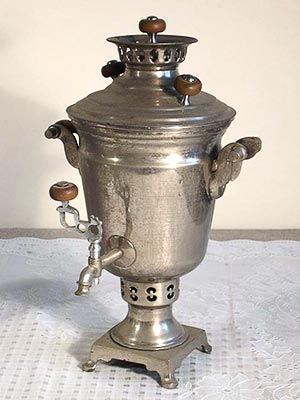
For more than 250 years, the samovar has
occupied an honoured place in Russian homes as the centrepiece
of the table, around which life revolved. It remains most stable
attribute of domestic coziness. Step by step a peculiar ritual
of tea-drinking emerged and was adopted in every Russian homes.
Drinking tea from the samovar was a way of life. A
traditional samovar consists of a large metal container with
a faucet and a metal pipe running up through the center. The
pipe is filled with solid fuel to heat the water in the surrounding
container and the teapot placed on top. The teapot is used
to brew the zavarka, a strong concentrate of tea. The tea
is served by diluting this concentrate with kipyatok (boiling
water) from the main container at a ratio of about 10 parts
water to one part tea concentrate.
Since the mid-18th Century, the samovar (Russian
teapot, literally from the Russian "sam" (self)
and "varit" (to boil)), glowing hot and polished
to a sparkle, was an indispensable feature of every day life.
Since its introduction to Russia from China,
tea has become a cultural staple. The samovar came to Russia
from Persia and the Middle East in the 18th century.
In old Russia tea quickly replaced favorite Russian drink
- sbiten (mix of hot water, honey and herbs) and became a
popular product. Tea was drunk all day long - you could find
hot tea sellers on street corners, in trains, in offices.
The samovars became the symbol of Russian hospitality and
family comfort as well as the sign of prosperity. Some families
held two samovars, one, more plain, for everyday use, and
a dearer one - for receptions and festivities. There were
homes with separate samovar-rooms whose interior was crowned
by the samovar. Russian people wanted something special and
began to decorate and develop the samovar into a beautiful
work of art, as welcome in the Winter Palace as in a peasant's
izba (hut).
The first samovar was made in Tula in 1820.
Later samovar manufactures were in many regions, but Tula
became known as the centre of Russian samovar production.
First samovars were made from cupronic-kel, red and green
copper, pinchbeck, in some cases - from silver. Sometimes
they were plated with gold, silver, but basic metal was always
- brass. They were sold by weight. If samovar was heavier,
it would be more expensive.
Tula samovars were spread all over Russia.
At the fairs samovars were sold of different shapes: vase-shaped,
pear-shaped, wine-glass-shaped and others. Samovars came in
various shapes and sizes depending on their use. Most were
small, around 18 inches high, and were used in homes and offices.
Larger samovars could be several feet in height and diameter.
Travelling samovars were equipped with handles and removable
legs. Others had compartments for preparing food. The metalworkers
of the Russian samovar factories provided exquisite detail
in silver, bronze, and iron.
Their decoration testifies to different stylistic art trends
echoing the general tendencies in the artistic tastes of different
periods.
Nowdays Russians still use the samovar quite
often, but mostly as an attribute of exotics and nostalgia.
Samovars are a necessary feature of the Russian mode of life
and consequently a part of Russian applied art.
However modern technology has provided for electric samovars,
which don't require the use of charcoal. As in old, these
samovars are found in kitchens, offices, and even on Russian
Trains. And the use of the samovar has spread from Russia
to much of Eastern Europe.
Every samovar with hand painting has its own style and is
not only article of arts and crafts, but also a good remembering
gift.
|

